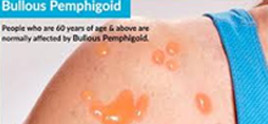Bullous pemphigoid (BP) is an autoimmune subepidermal blistering disease that mainly affets elderly patients, although childhood cases do occur. Its very challanging condition for dermatologists. Subepidermal blistering is mediated by activation of complement and release of tissue- destructive proteases following IgG autoantibody complex formation with hemidesmosomal antigens BPAg1 (BP230) and BPAg2 (BP180 or collagen xvII). According to skin specialists The clinical hallmarks of the eruption are tense bullae with either generalized or localized distribution; however, variants, including urticarial, vesicular, vegetative, erythrodermic, and nodularis, have been described. Pruritus associated with BP can be severe and adversely affects quality of life. Mucosal involvement with small blisters or erosions may exist in a minority of patients. Although Dermatologist in Delhi says there can be relapses and exacerbations, BP is generally self-limiting, with remission in most adults by 5 years, and more rapidly in children. Mortality can be high in patients with poor overall health and advanced age.


